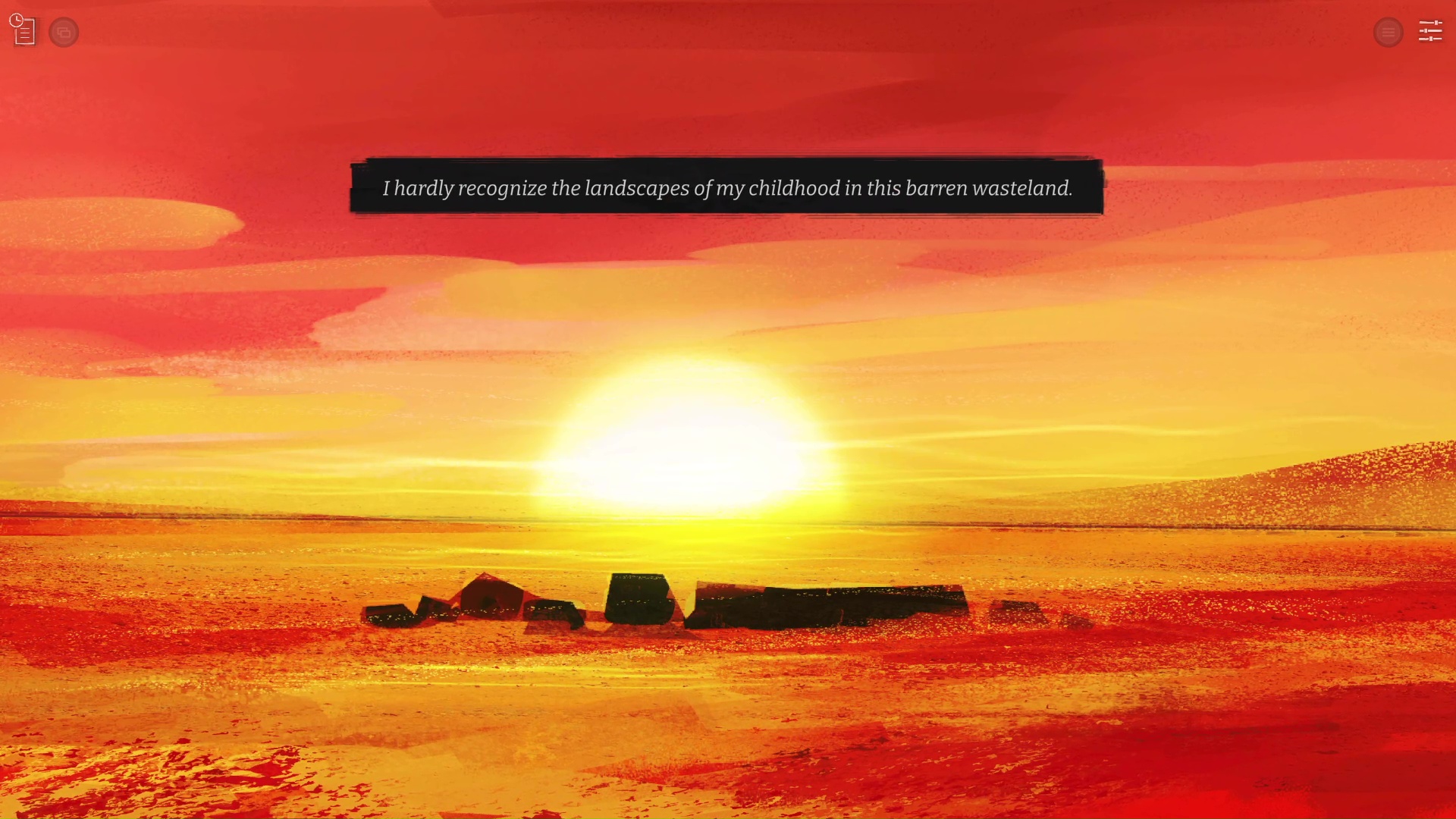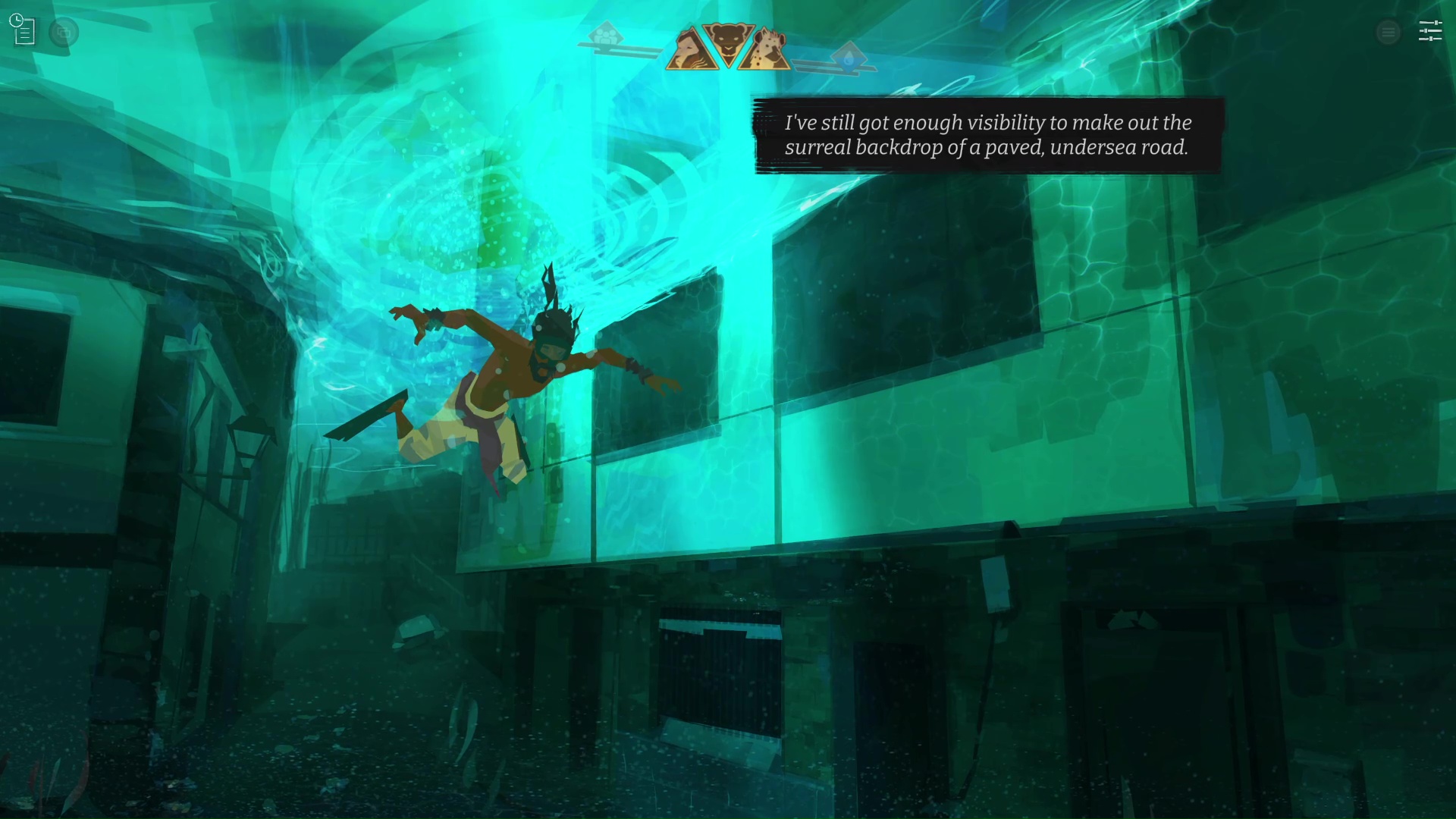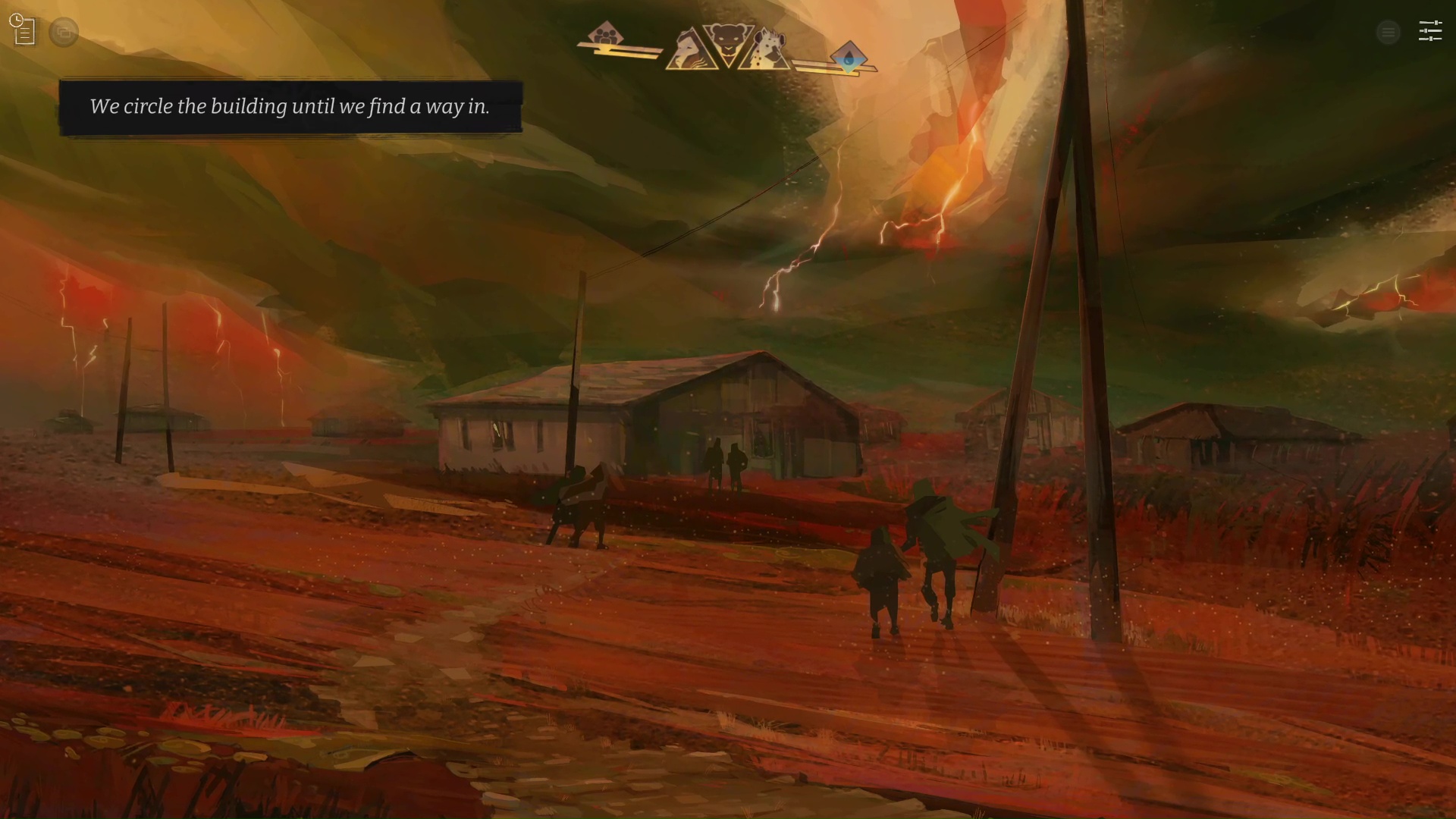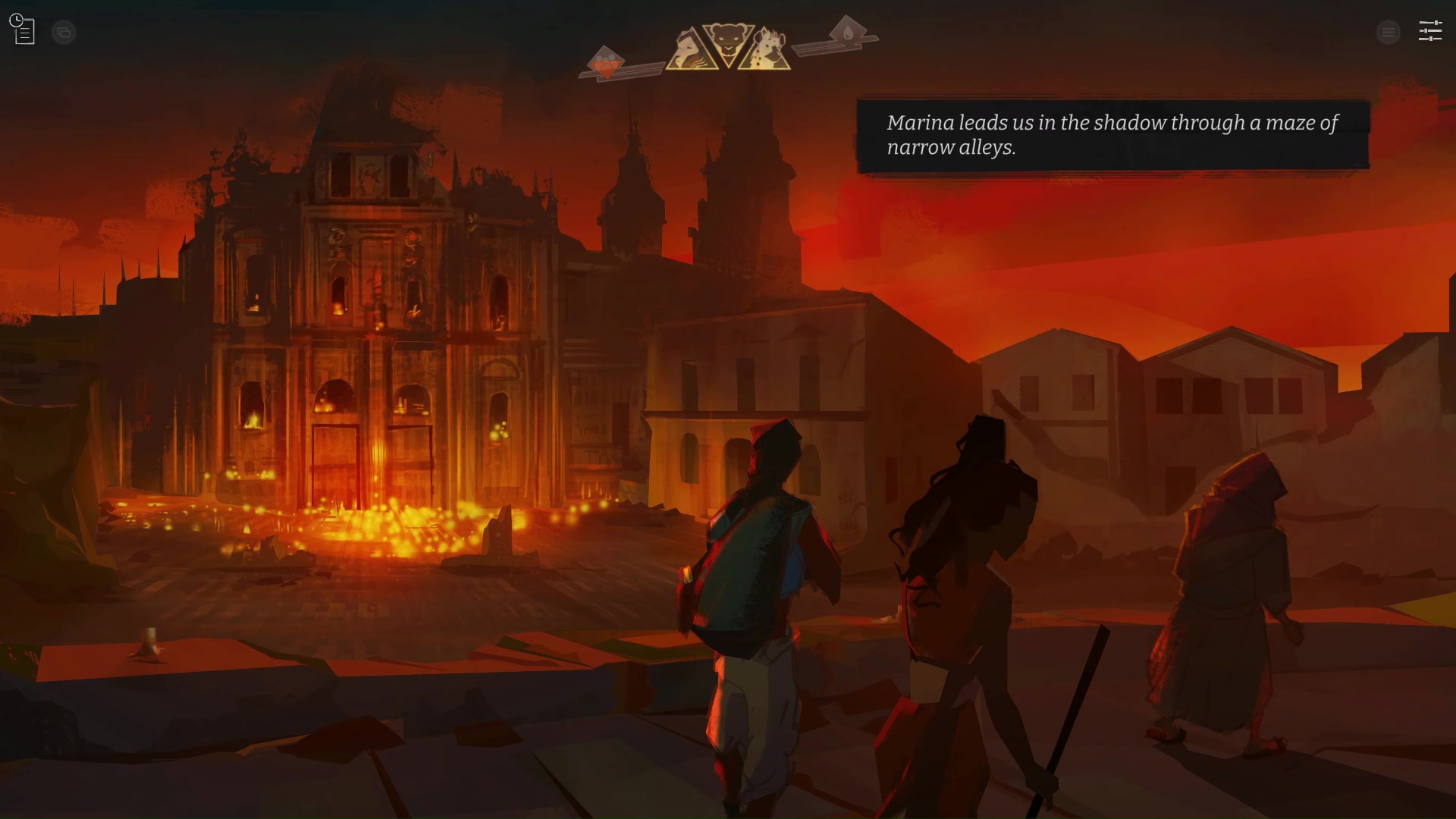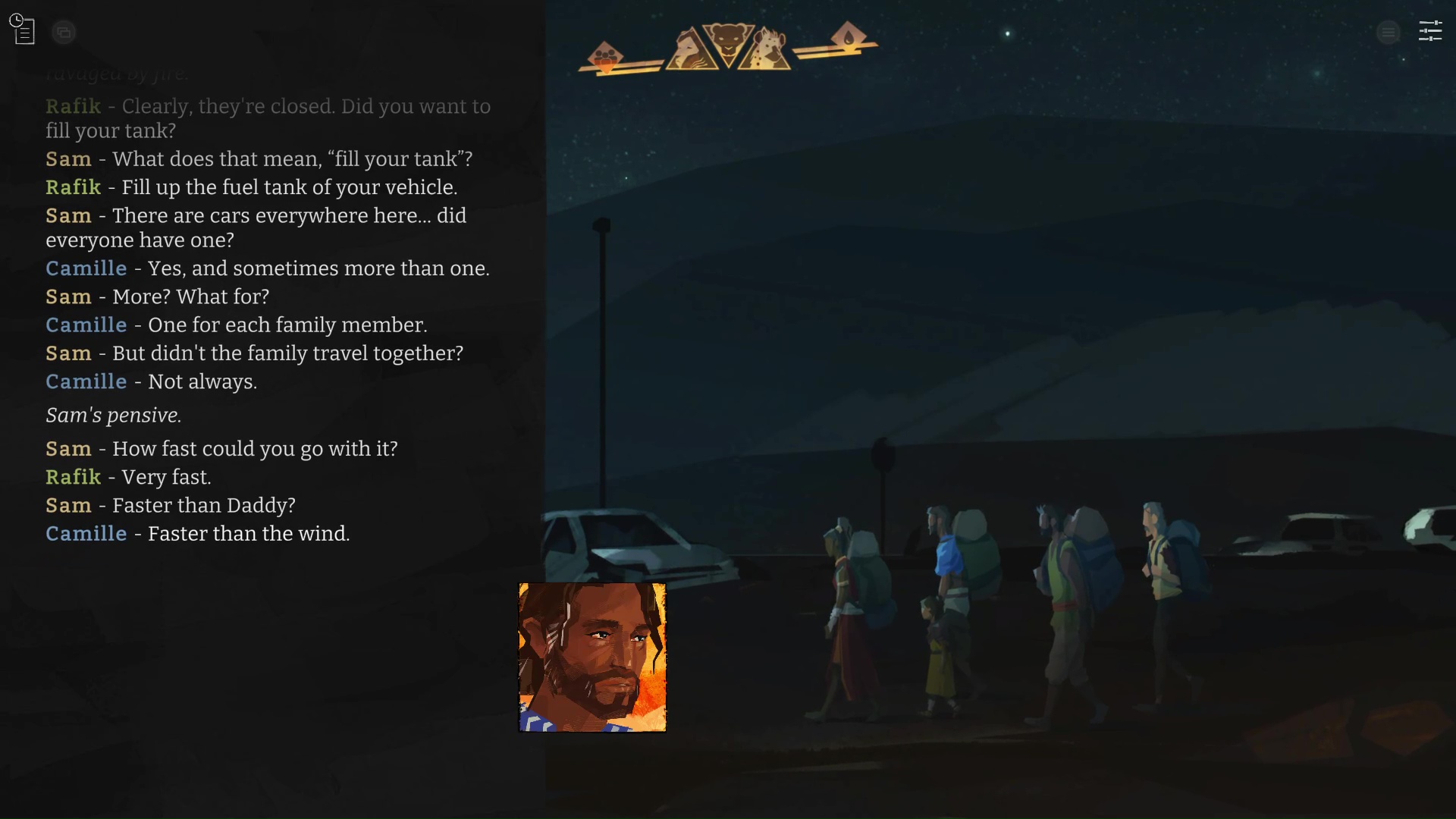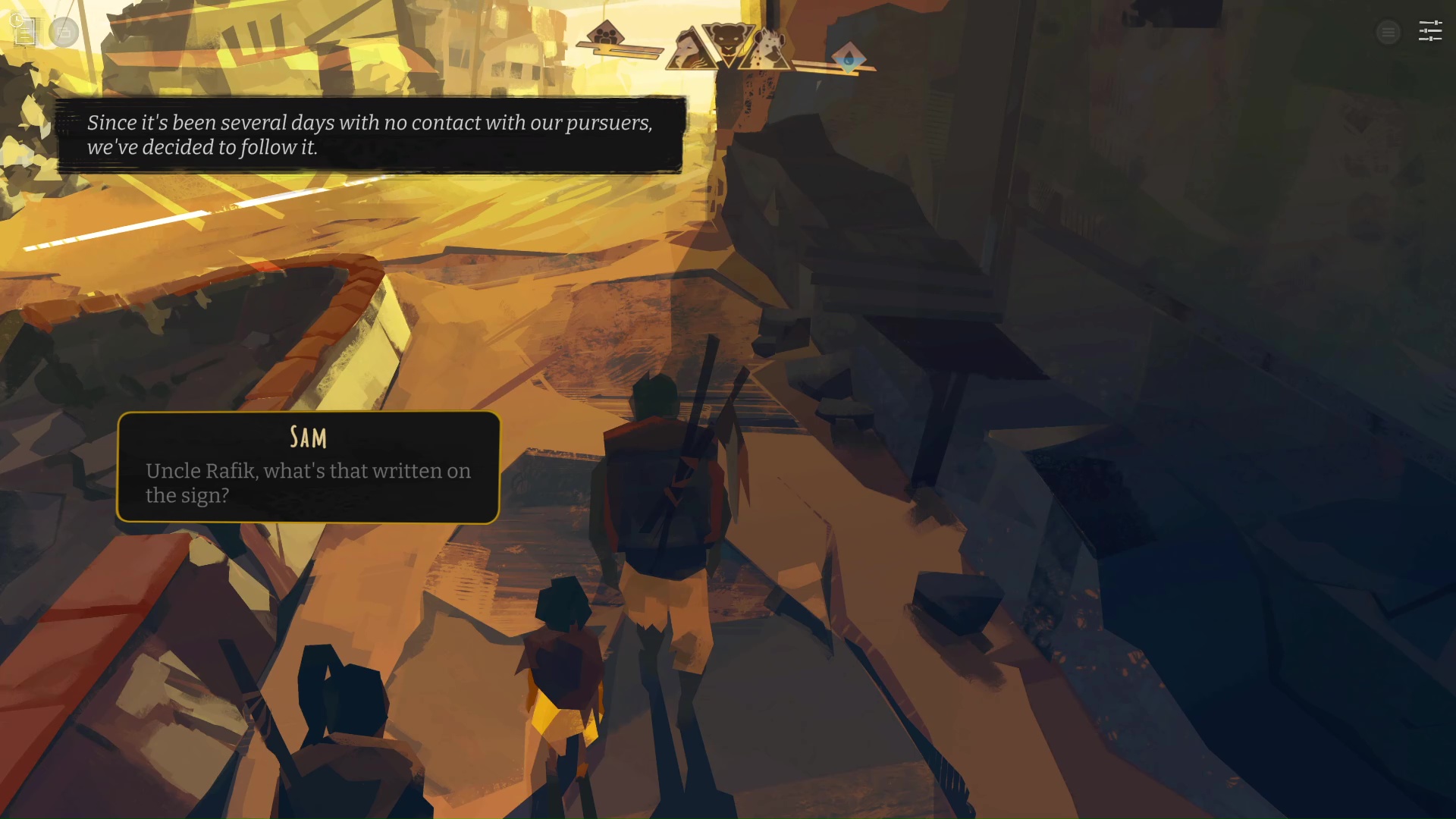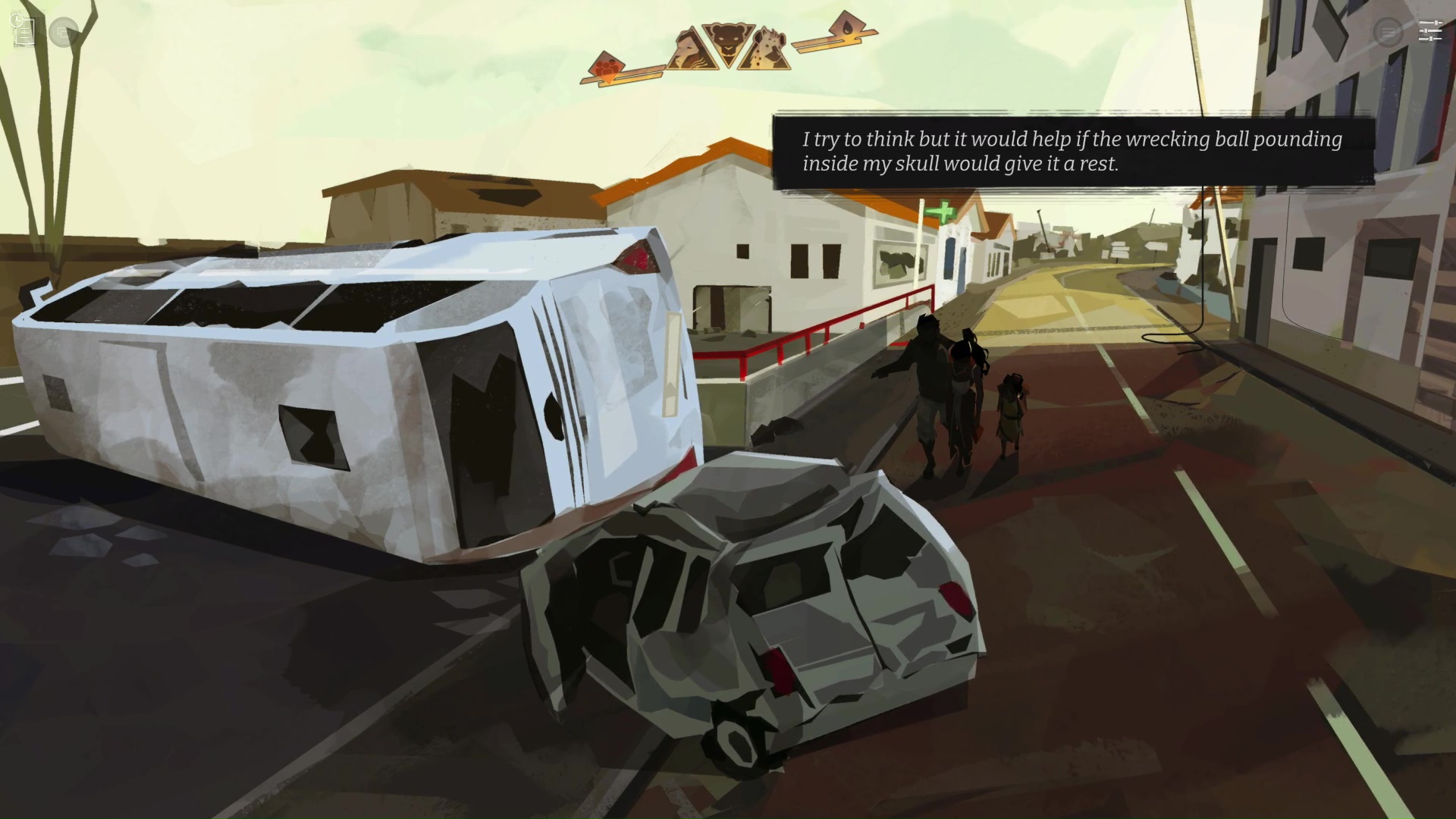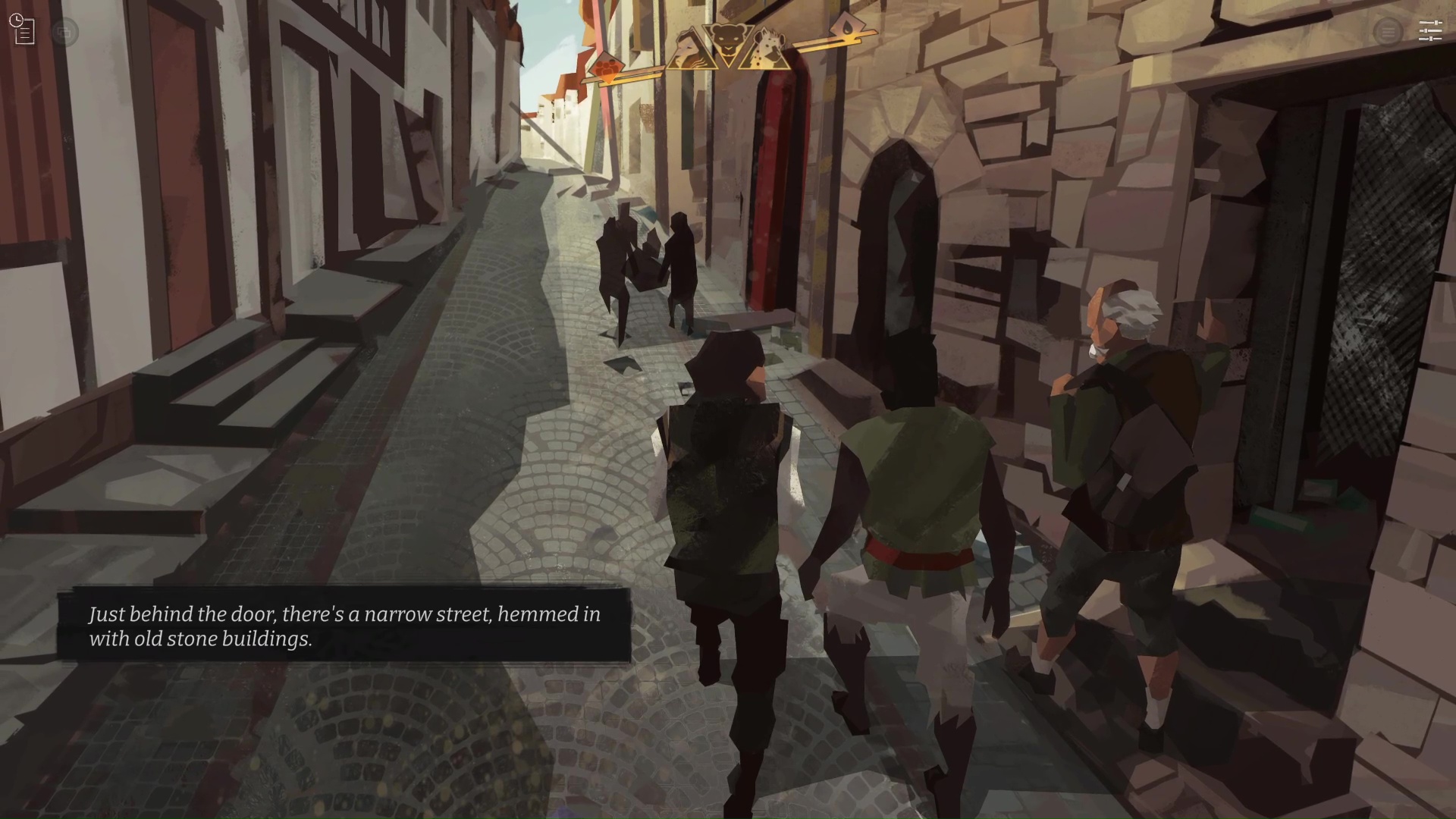REVIEWS FROM THE COUCH
End of Lines
End of Lines
PUBLISHED
ULTIMA MODIFICA
25 May 2025
25 Maggio 2025

GAME INFO
Title: The End of Lines
Year: 2023
Release Date: 25 May 2023
Developer Nova-box
Publisher Nova-box
Genre: Storia Interattiva
Tags: [coming soon]
RECEIVED FOR FREE
(Game Key from the Devs)
ACCESSIBILITY
Input Keyboard, Controller
Lingua: English, French (No Italian)
Subtitles: X
Voci: X
ITA: X
Trigger Warnings
TWs spoiler important parts or endings, thus are hidden.
- Corpses
- Mutilations (mention of)
- Homicide
- Violence
Credits
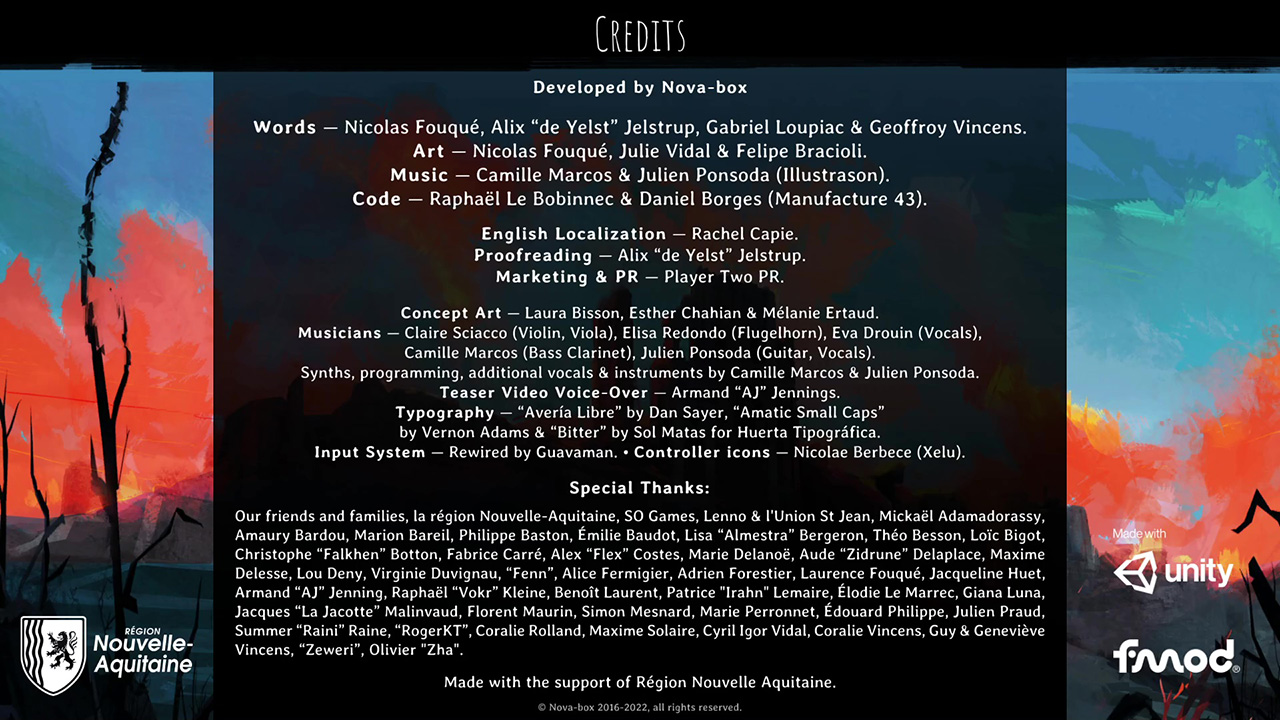
going deep down
going deep down
Introduction
End of Line came to me at the time of release, in May 2023, as a free key (along with another game, which I have not reviewed at the time of writing), following that of Delete After Reading, as all three games were followed by the PR group PlayerTwo (now Mooncat.
At the time I had no idea what it was, nor had I ever heard of it. And so it continued to be until December 2024 (time of writing), due to my complete neglect of the project, due to ADHD.
Mindful of my commitment, speaking of due reviews, I decided to honor my debt and play it, convinced that it would be a rather simple story about a group of travelers in a hostile environment and in the near future (which you know, I like to play in the dark about as many details as possible).
Was it?
Yes and no.
If at first I had doubts about being able to play it, since the text was a lot and at the moment my attention span - unfortunately - was very low, I must say that instead it was a very pleasant surprise, as you will understand better below.
Thank to ex-PlayerTwo (now MoonCat) and Nova-Box infinitely for the opportunity!
Story
Ok!
In a not too distant future towards the end of our century, in which the sky has taken on the colour of fire, on an Earth devoured by desertification and the consequences of global warming (or "global boiling", not "simple" global warming), somewhere in the Sahara desert on the border between Algeria and Niger, the Matriarch of a tribe that has been struggling for years against the increasing heat, must make a terrible decision: to push her eldest daughter and heir, Nora, to choose, together with Rafik, another man in the group, the volunteers with whom to abandon the tribe. Also going with them will be Sam, the child of Nora and Camille, her husband, a stranger who came from the "north" and who can therefore return there assuming that the conditions in those lands are still livable.
Although she cannot be certain of the success of this mission without return, the Matriarch knows that staying means inevitable death for everybody without exception. In this case, an uncertain fate is better than a certain condemnation.
Pur conscia che questo esodo condannerà la madre e tutti coloro che rimarranno lì, Nora non può far altro che accettare ed obbedirle.
Thus begins the group's grueling journey, in the hope of finding a more hospitable place to live, "up north".
The game, after the introduction to both the characters and the setting, takes us one year from the departure: from here we will collect information and details one scene at a time, through the dialogues the story itself. We will discover where they are, in which direction they are traveling and what happened in the previous twelve months.
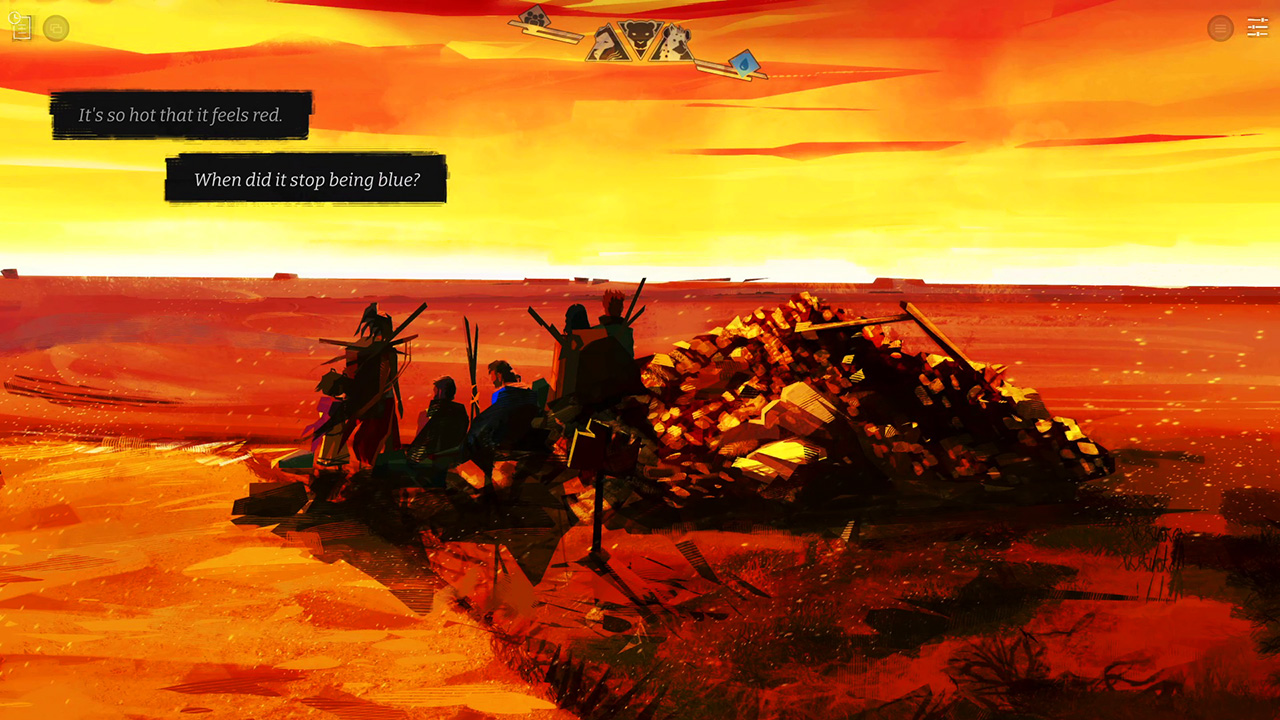
Visual Style
Ok!
The graphics are something you probably have to get used to.
It's been a few years since I first got into interactive fiction and visual novels, but I'm no more knowledgeable than I was back then.
I'm a fan of point-and-click and puzzle games, after all.
One thing I've often noticed about it, though, is how graphics are considered a rather important element, probably in the face of simpler animations and a gameplay that is necessarily more static. It doesn't matter the style, whether more realistic or more in comic style, whether more manga or anime, whether more Western or more Eastern, it will often focus on the characters and their details, on the environment and what happens.
And here?
The graphics here are a visual adventure.
Extremely artistic and with an intense palette, on the "concept art" genre in style and level of detail: everything is very sketchy and there is nothing even just defined. Much of what we lay our eyes on is created by rough landscapes and hinted features, spots of warm and hypersaturated colors to convey the extreme level of heat and the flames that dominate our poor Earth. Heat rapidly rising to ever higher latitudes.
This is what you would expect in the development phase of the game, when you work yourself to death with concept art and storyboards to decide what you want to represent and how, with what vibe and mood, before moving on to the next phase of actual image creation. Yet, despite this, the scenes can be extremely rich and full of details, without making the viewer feel like something is missing and offering a world that tells its own story.
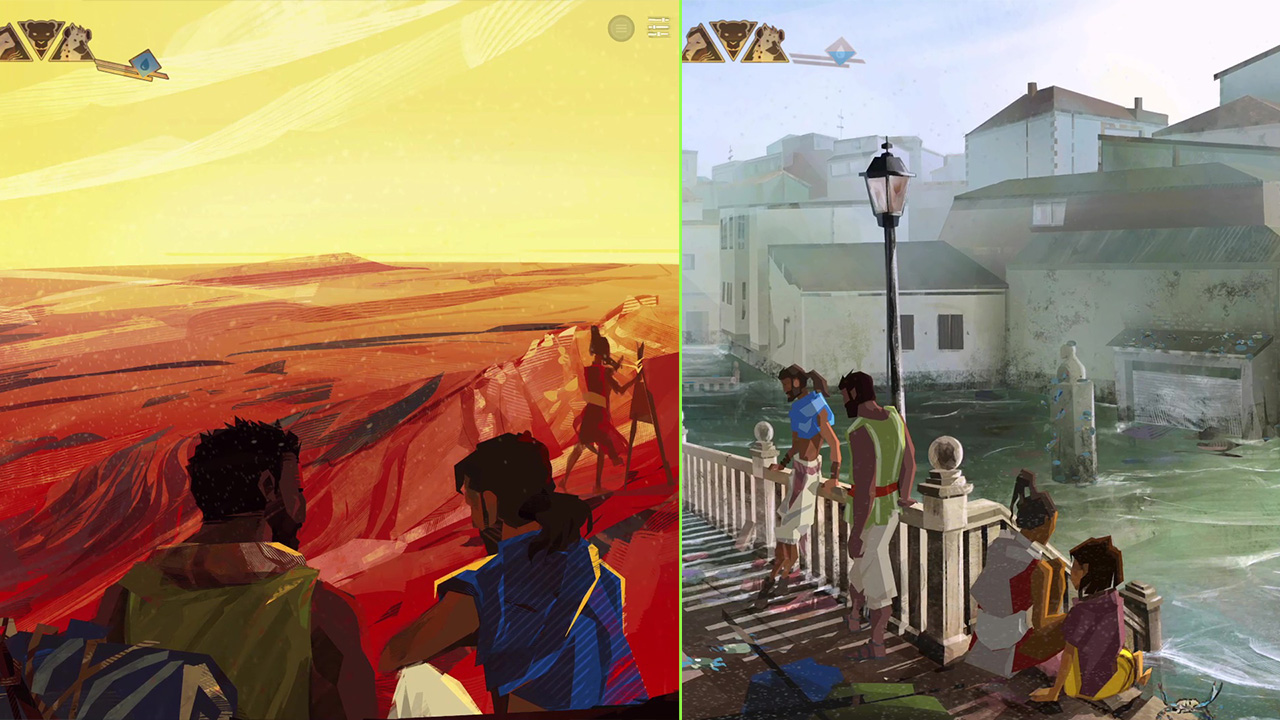
Getting used to it is obviously inevitable, so if you don't like it right away, give it some time. This happens with any game, unless it's something really weird or very retina-unfriendly.
Or stomach-unfriendly.
When I got used to it, I had a bit of an epiphany: I went from only noticing the low level of detail to realizing how, with a few well-distributed digital brush strokes and a wise use of the really loaded palette, hostile environments like the climate that devoured them were perfectly delineated.
The vastness of the scorching desert surmounted by the hellish sky, the coastal towns lapped by the grey water of the seas that have half swallowed them like dull demons deaf to any prayer, the green of the vegetation along the streets as tired as the plants it colors, the neutral colors of walls and stones in contrast with the richly colored fabrics of the travelers, the last remnant of a culture now extinct.
Each shade paints the path they travel day after day, as they watch the changing landscape, the earth becoming scorching hot and slowly reducing hope to ashes.
Sometimes you will even have the impression that the illustrations were created by different hands. The details change, as does the way of representing the individual characters, the digital brush strokes, the textures used. Not that it is a big deal, of course, but these are also the details I focus on, imagining the developers at work, to understand how a game was created.
However, not only do I have no way of knowing whether this impression of mine is true or not, but in reality it is not even fundamental: it is always the final result that counts, not how it was achieved and how the individual parts were created.
Game Mechanics
Ok!
The game's narrative is not complex, in fact, it is decidedly linear and is divided into six chapters plus the epilogue.
From what I've seen there are many forks in the road that influence the narrative and, investigating a bit after completing it, there seem to be four different endings.
The achievements reflect this variety well and, similarly to other games of this type, it is not possible to complete them all in a single playthrough. For lovers of the genre it is certainly an additional incentive to challenge its replayability.
Archetypes: Choices and Decisions
Durante il dialogo iniziale tra Nora e sua madre, verremo a conoscenza di una storiella che coinvolge un Leone, una Pantera, uno Sciacallo e un Tahouri (il termine con cui nella lingua berbera ci si riferisce alla iena, credo. Su internet ho trovato pochissime informazioni).
Questa storia, che non anticipo, sarà la base per la spiegazione dei tre archetipi principali che guideranno il gioco, ognuno rappresentante uno dei tre protagonisti.
Nora, the Lion:
- favors direct approach and confrontation
- seeks to arm herself and strike first
- is suspicious of others
- always expects the worst
- is ruthless
Camille, the Panther:
- avoids confrontation
- prefers to flee danger
- displays doubt
- doesn't like to stay in one place
- sacrifices himself for others
Rafik, the Tahouri (Hyena):
- seeks out social interaction
- eagerly accumulates wealth
- strives to establish exchanges
- will manipulate others
- prefers the sedentary lifestyle
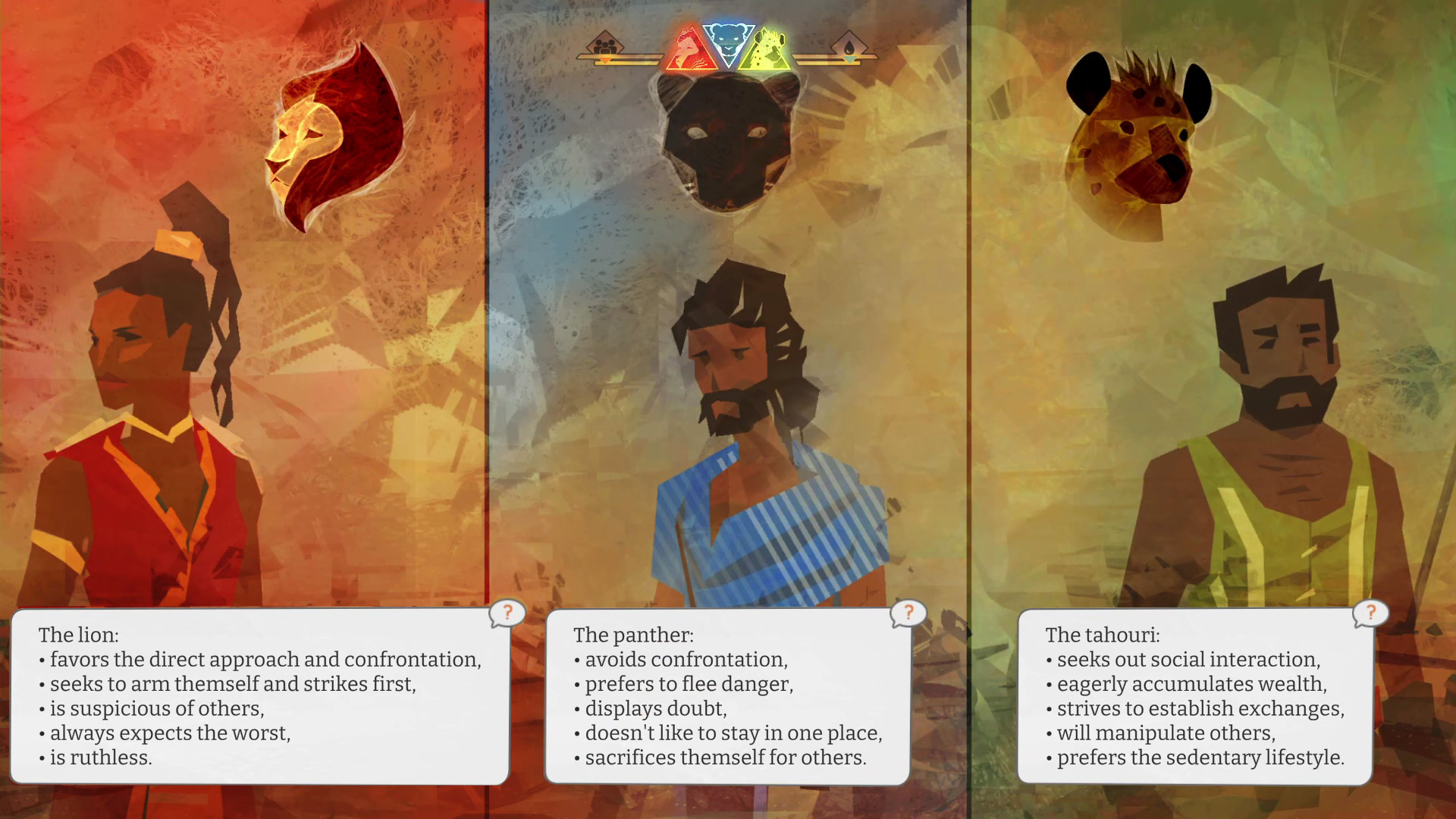
Every decision you make will belong to one of these three archetypes and, beyond the consequences that derive from them, their sum will also influence the narrator of the story. In fact, if your approach is not that of the current narrator, it is possible that this will change: at the start it is Camille and if, for example, you are more Lion (therefore aggressive, resolute and distrustful, with little room for empathy when talking about survival) or more Tahouri (you seek contact with the people you meet and to approach/parley with others with exchanges and fables) than Panther, at a certain point the narration will pass to Nora or Rafik.
Quando fate una scelta, saprete a che archetipo appartiene osservando quale delle tre icone degli animali si illumina, in alto nella schermata. Tenendo vagamente conto di quante appartengono a quale, potete farvi un'idea su quanto è possibile un cambio di narratore.
Al momento in cui scrivo, tuttavia, non ho fatto esperimenti specifici per sapere quante risposte di un certo tipo siano necessarie per far scattare il cambio, né mi è capitato durante la (per ora unica) partita che ho fatto.
Il mio narratore è cambiato, sì, ma per altri motivi slegati da questa meccanica.
There is no graphical meter in the game to track this, though.

Ovviamente questa è la parte "interattiva" della storia, un po' racconto e un po' gioco di ruolo, e di conseguenza non c'è giusto e sbagliato nelle vostre scelte e decisioni. Gli approcci possono essere diversi, come ad esempio scegliere ciò che -voi- scegliereste oppure ciò che pensate che quel determinato personaggio sceglierebbe, cercando di rispettare i punti cardini dell'archetipo a cui appartiene.
O anche no.
L'unica cosa che sconsiglio di fare è preoccuparsi dell'eventuale cambio di narratore e tentare di evitarlo: è una dinamica che fa parte del gioco e che gli sviluppatori hanno voluto e, se capita, un cambio di punto di vista non può certo far male!
Travelers and Supplies
L'altra meccanica principale riguarda le provviste.
Se non siete fan dei survival non preoccupatevi: lo è solo sulla carta, non dovete attivamente cercare niente da nessuna parte. In determinati momenti sarà la narrazione ad offrirvi l'opportunità di cercarne.
You can put your dose of anxiety back in the drawer.
Provisions are literally what the name says: water and food to survive, which the protagonists find around either by scavenging (such as in abandoned buildings or shops) or from the environment (such as rivers, wells, springs). There is no real inventory and the exact amount of what you have at a given time is not represented in an absolute way, but only in relation to the number of people who are part of the group at that moment.
Ovviamente, più il gruppo è numeroso, più velocemente le provviste si ridurranno essendoci più bocche da sfamare e dissetare. Questo chiaramente mette a repentaglio la vita degli altri ed è possibile che alcuni dei viaggiatori finiscano ad abbandonare la compagnia.
Anche qui però, non preoccupatevi: fa parte della storia anche questo e se dovesse capitare, non prendetelo come un fallimento, anzi, avrete l'occasione di vedere evoluzioni altrimenti non accessibili.
Fighting to survive, given the extreme setting, is completely realistic!
In this regard, however, another dynamic comes to our aid.

Camps and Explorations
Whenever the narrative includes finishing a day's journey, the travelers will have to build a camp to rest. This does not always happen at night: depending on where they are, they may travel at night and rest during the day to escape the heat, or vice versa if they are in a colder area.
When it's time to set up camp, the option to go on a scouting tour for supplies will be offered, and a list of available people will be made, indicating who is too exhausted to go. Typically, those who went on the previous one will not be listed for the next.
Le opzioni sono molteplici: intanto si può decidere se andare o non andare e nel caso si decida per esplorare, è possibile decidere in quanti andranno e chi nello specifico. Se capita che ci siano dei volontari, la narrazione lo specificherà.
Nel caso in cui si decida invece di non andare per qual si voglia motivo, è possibile che le cose si complichino a seconda di quanti si è e di quante provviste si hanno. Capita però che andare possa causare più problemi che permettere a tutti di riposare.
Anche Sam, nonostante sia un bambino, può partecipare.
During the story, however, there will also be some collateral opportunities to look for other provisions but not only: the findings can in fact include other supplies like first aid kits, blankets, clothes and so on.
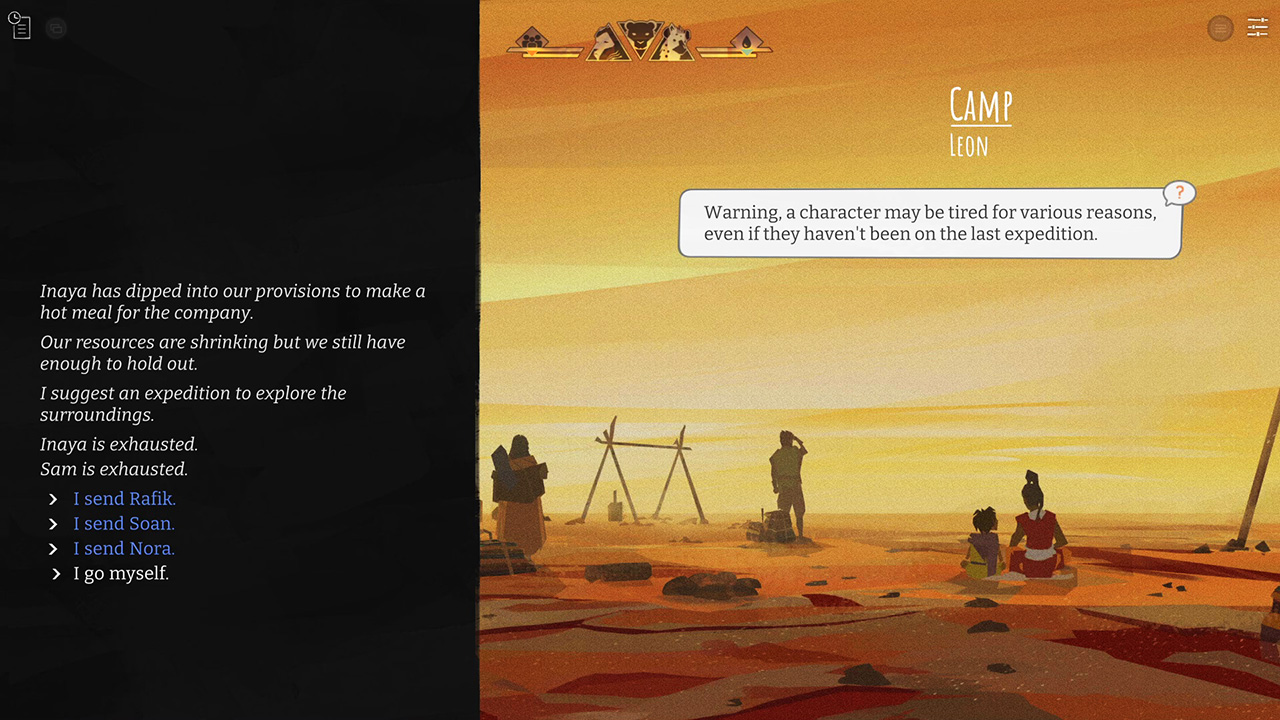
Soundtrack
Ok!
There is music, but it is really very little.
In almost seven hours of play, I found maybe ten scenes - or so - that had some kind of soundtrack: a stop at the camp, a memory, a moment of tension or danger, an important experience, a crucial meeting, etc. I could quantify the music, roughly, as one cameo every hour.
But why do I speak of it in the singular?
Because not everything that is similar in the game automatically has background music. Not all the moments of danger, not all the memories, not all the scenes at the camp.
I asked myself, therefore, if they were really very specific situations, pregnant with the narrative or if it was simply a choice of "narrative choreography", where maybe they inserted a track every so many moments of the game, or something like that. However, I did not investigate enough to be able to provide a decent answer even to myself.
And when there is no music?
Well, deafening sounds and the nature that produces them dominate: buzzing, people's voices, the howling wind, the crackling of the dried-up skeletons of what were once plants but still suffer from the extreme heat.
Or the silence.
There are sometimes whole half hours of almost complete silence, which weigh like a millstone when you realize that the group of travelers is the only lump of life in the space of tens of square kilometers of parched desolation: there is not a single chirp, a second of a cricket's chirping, a random animal that makes its voice heard in the distance.
There is NOTHING around them.
Only the peaceful, motionless hostility of a world that is losing (or perhaps has already lost) the resilient yet fragile balance that allowed life on its surface (while ANXIETY builds up around you).
The Industrial Revolution and a handful of centuries were enough to do what millions of years could not do, millions of years of history during which generations of creatures have come and gone, men have emerged from the dust and returned to it at the hands of their own kind and kin, civilizations and kingdoms have risen and fallen without anything inevitable happening.
A tear in the immensity of time, a breath sufficient to make the first piece of the domino fall that dragged with it all the others and that not even the earthquakes had previously moved.
And it is precisely during this lack of soundtrack that immersion soars and climbs the highest mountain, managing to give immense depth to a game that, in fact, is not only merely 2D but does not even have animations.
We could almost define it, more than a visual novel, an interactive audiobook (the difference, in some cases, could be a really thin line, I realize!).
Other
Duration: 6 hours and 45 minutes approximately.
However, it should be noted that I advanced rather slowly due to the gameplay being recorded, so as to allow viewers to read the dialogues without pausing the video.
Performance: perfect!
Bugs: no bugs crawled out!
Notes
No note here!.
My Thoughts
Ok!
This game was, for various reasons, a little roller coaster.
Never in the negative sense of the term, rather, more in that experience of "nice but..." that sometimes characterizes playing games that we are not too convinced about and that we occasionally end up playing or choosing for reasons other than what usually leads us to purchase.
Speaking of the plot itself, I have to admit that it is one of the post-apocalyptic scenarios that most worries me, because unlike other types of disasters on a global scale, the heat and everything related to the extreme increase in temperature seems frightening to me. Something that imagining a contrary scenario in extreme cold instead doesn't do, like Frostpunk (which no, I haven't played D: )
Maybe it's due to personal inclinations, or because I have the impression that we are already touching a little too solidly the potential beginning of this disaster.
L'odissea dei protagonisti mi ha tenuto la gola arida e con una bottiglia piena d'acqua perennemente al fianco (giuro, non ho idea di quanto ho bevuto per riflesso), e se inizialmente l'idea di giocarmelo in inverno e non in estate m'era dispiaciuta per l'occasione mancata di una maggiore immersività/immersione, arrivati al terzo capitolo questo pensiero mi era già completamente scomparso.
Sono uno che per quanto adori la primavera e non gli dispiaccia l'estate, odia le temperature sopra i 25°C con tutto il cuore.
If I really have to choose a disaster between the two extremes, I'd definitely go for the cold: I've seen I don't know how many documentaries and videos about the extremely cold regions of Russia such as Siberia and the Republic of Sakha (Yakutia), where temperatures can reach -60°C/-70°C (and where children only stay home from school if the cold goes below -50°C/-58°F!), and it seems less terrible to me than imagining the Sahara on fire.
Perhaps it is a false impression, but in my mind, humans have a better chance of surviving and making do in a scenario of extreme cold, than in an extremely hot one where any liquid becomes extremely scarce, because this is precisely one of the fundamental discriminants: the availability of water.
The game, despite the more static format of interactive narrative, manages to easily project the player into this extreme world, both in terms of space and time, without having to make great flights of imagination. A quality that not often can be boasted of with regards to games of this genre.
To imagine hundreds of square kilometers where the most available are rare puddles and where even the Berber and Tuareg populations have made weapons, honestly devastating.
~°~
Staying on the environmental issue, I have always believed in the power of stories: well-told stories that can make you empathize and reflect, giving you that negative thrill you need to understand and put yourself in the shoes of the character through whom you are experiencing the adventure or to see situations that are alien to you in a much more realistic way.
For a long time it was a task reserved for non-interactive media such as books, radio, television, but in the age of video games we can actually touch with our hands much of what once could only be imagined or followed as it scrolled on the screen, without decision-making power and with distractions always around the corner. The analyses always came at the end.
Now, however, video games allow us to experience stories much more directly and responsibly, and understand much more closely what a certain situation is like or what certain consequences mean. Of course, the analyses still come at the end, but with the difference that we must or can stop even during the story, to think about what we are doing and in which direction we are going, in space or in intentions.
In this case, it is heartbreaking and distressing to follow the conditions in which Camille or whoever the narrator is forced to live and travel, because the game and the narration allow us not only to feel directly in our minds the heat that undermines their survival, but also to have to make decisions that, we are always aware, will have consequences. If we are lucky they will be positive consequences, if we are so-so they will be neutral but if we make bad decisions we will have terrible consequences that will weigh on our conscience.
It is true that we often have to make bad decisions to experience certain branches of a story and achievements help us push ourselves to make choices that we would otherwise never make and to experience dramatic sides of a story that we are not always willing to explore spontaneously, but this does not take away the fact that we must do so aware of what it means.
Just as we need to do now, in these first decades of the 21st Century, where the future is uncertain and does not look good or pleasant, if we do not get it into our heads to do something, not just to slow down, but to stop what is happening.
Needless to say, the reality of End of Line is reasonably realistic, in the wide range of plausible "what ifs" that we can put in the deck, with the hope that those who deny, those who do not want to listen, can experience something emotionally, get a sense of guilt, a qualm or even just a doubt sufficient to push them to change some of their bad personal habits and fight the hyper-consumerism that is already massacring us now.
~°~
As for the progression of the game instead, during the first 2-3 chapters I was convinced that the weight of the dialogue choices was not too much. The impression I had was that yes, they influenced the narration slightly and that they led to short deviations from the main one, but only to give the possibility of seeing more scenes as a reward for having made riskier or less linear choices.
A detour, so to speak, before returning to the main story and picking up where everyone, inexorably, had to go.
Invece no. Tutt'altro.
Il peso è assai più apprezzabile e non solo al punto da cambiare (ovviamente) l'epilogo finale ma anche da cambiare il narratore della storia in corso d'opera.
Come ho detto in "Meccaniche" però, personalmente mi è capitato ma non come conseguenza della somma degli archetipi delle mie scelte.
However, we must be patient> and allow the story to progress before encountering situations in which our choices will have more impact and greater consequences, both in terms of the direction the narrative can take within the world and in terms of forks in the road and divergences between one choice and another.
~°~
As for the LGBTQIA+ themes, the game also addresses these albeit marginally, not being the core of it. I don't want to give any kind of spoilers about it, so I won't say anything about where, how or at what point in the game you come across them, but I have to say that I really liked the naturalness with which they were inserted and the way they were treated.
I really appreciated that, precisely, it was exposed as "a human issue among many others", in the same way as how the sky is no longer blue or surviving is difficult and that the issue is exposed and unfolded in a natural way and without great theatricality or artificiality.
I say this not only from a game-reality perspective, but also from a game-worldbuilding perspective.
And speaking of which, I really appreciated the fact that the issue was also included culturally, although I don't feel like expressing myself on whether it represents the reality of that culture or not, not belonging to it directly. Consequently, I leave the word to those who are more informed than me and let's say that, seen from the outside and with the general notions that I may have on North African populations, it sounds at least credible.
Obviously we hope it's not stereotypical.
~°~
Related Articles
If there was something I wanted to discuss more deeply, it's here!
No related article here
(perhaps "not yet"!) : D
In Pills
In Pills
Recap
YASS
Current story on global warming
North African protagonists
LGBTQIA+ insights included
- Beautiful worldbuilding
Numerous crossroads and epilogues
SO-SO
If you don't like long dialogues, here they'are the basis
- In dialogues, response choices often correspond to decisions to be made.
Limited save slots
Relax-O-Meter
- = to be taken into consideration
- = for some it could be a problem
- = minor bug/glitch or issue
- = serious bug/glitch or issue
Watch The Video
Watch The Video




